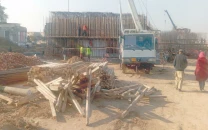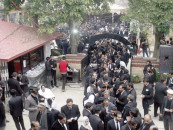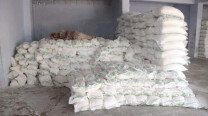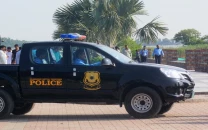REPLUG: Who was Mangal Bagh?
He was truck driver or, according to some, bus conductor who belonged to smallest of eight sub-clans of Afridi tribe

He was a truck driver or, according to some, a bus conductor. He belonged to the smallest of the eight sub-clans of the Afridi tribe. He had no formal education but a few years in madrassa. He also spent some time with a secular political party. Then intriguingly, in less than five years he became a top militant commander. This is Mangal Bagh, the chief of Lashkar-e-Islam militant group, who virtually ruled Bara tehsil of Khyber Agency until June 2008 when he and his armed vigilantes were driven out in a security operation.
They fled Bara only to regroup in the remote, idyllic valley of Tirah, which has since become a potpourri of militants. Bagh’s arrival set off a deadly turf war in the valley strategically located on the confluence of borders of three tribal agencies, Khyber, Orakzai and Kurram. However, Bagh had largely disappeared from the headlines until mid-October this year when a military operation, Khyber-I, brought him back into the spotlight.
Many wonder why it took the military four years to go after Bagh and his fighters in their last bastion. “Several militants had slipped out of North Waziristan Agency before the start of Operation Zarb-e-Azb and sneaked into Tirah,” a security official told The Express Tribune. “We decided to chase them. So, you can call the ongoing operations in Bara and Tirah an extension of Zarb-e-Azb.”
Lashkar-e-Islam is not a franchise of the Tehreek-e-Taliban Pakistan, the fractured umbrella of extremist groups operating in the tribal regions, but Bagh did maintain a symbiotic relationship with the TTP. And this is why the group said on Friday that it will reinforce Bagh against the security forces.
The official revealed that phase-I of the operation has been successfully completed and now phase-II is under way. “Nearly 100 militants were killed and over 100 – including some key commanders of Mangal Bagh – surrendered during phase-I. Eight soldiers also died in fighting until Oct. 26 when phase-II was started,” he added. “Phase-I was conducted in the areas along the border with Kurram and Orakzai – from Jarobi, in Khyber Agency, to Kalaya, in Orakzai,” the official said. “Phase-II is focused on Bara.”
Another security official further explained the goals of these offensives. “Our main objective was to stop the west-to-east movement of militants and to plug the gaps along the porous border between Pakistan and Afghanistan,” he said referring to the sanctuaries of Pakistani Taliban on the other side of the Durand Line.
Mangal Bagh is a member of the smallest Sipah sub-clan of Afridi tribe. The Sipah area in Tirah Valley borders Nazyan district of the southeastern Afghan province of Nangarhar. Bagh also maintains bases in Nazyan, the home of the Pashtun Shinwari tribe that straddles the border. Bagh had survived at least one US drone strike and fought a bloody battle with the Afghan Taliban in Nazyan.
Militancy in the Pak-Afghan border regions is mainly fed by narco-money. Tirah Valley, where the writ of the state is endlessly challenged, has gained certain notoriety for poppy cultivation. Across the border, Nangarhar is also a major poppy growing area and a base for drug laboratories.
“The reason for launching Khyber-I in Oct was to choke this major source of funding for militants,” the first official said. “September, October and November are poppy cultivation months. And we wanted to dry up funds for militants,” he adds.
Security forces have conducted a series of operations in Khyber Agency, especially Bara and adjoining areas of Orakzai and Kurram since 2008. These include Operation Sirat-e-Mustaqeem (Righteous Path), Operation Daraghlam (Here I Come), Bya Daraghlam (Here I Come Again) and Khwakh Ba De Sham (I Will Fix You).
Local tribesmen and security analysts, however, had doubts about these operations which couldn’t quite disinfect the region of militants. Security officials, however, defend these operations and cite the treacherous terrain of Khyber as a reason for the reemergence of extremists. “In military jargon clearing an area doesn’t mean combing it inch by inch,” a security official said. “When certain axes specified by the forces are secured, the area is declared ‘clear’.”
“Khyber is a strategically located agency which shares border with Orakzai to the south, Kurram to the southwest, and Afghanistan in the west. This makes the movement of the militants to and from here easy,” he said.
Former critics believe this time around the security forces really mean business. “The fact that a son of Mangal Bagh has been killed and several important commanders and foot soldiers of Lashkar-e-Islam have surrendered to the security forces shows that they want to crush them,” a tribal source said. Bagh’s son Israfeel was shot dead along with one of his top commanders, Hanif, by gunmen in Bara on Oct18.
Counterterrorism experts also agree – but differ on the reasons. “The withdrawal of US-led foreign forces from Afghanistan will complete by December this year. Pakistan wants to ensure a trouble-free exit of foreign forces. And this is why the security forces want to secure the main transit route for exiting forces that passes through Khyber,” said Dr Raza Rahman Khan Qazi, a counterterrorism expert and visiting professor at University of Peshawar.
“Moreover, our security establishment also fears that if the Afghan Taliban join hands with their Pakistani namesakes, together they could pose a serious security threat for Pakistan past 2014,” he added. “They want to cleanse the tribal belt and push the militants across the border. Now, it is for the Afghan government to mount a similar offensive on their side of the border to sandwich the militants.”
Ostensibly, however, there is no such realisation in Kabul. Instead the Afghan intelligence agency, the National Directorate of Security, is allegedly using the Pakistani militants as proxies. “Pakistani Taliban are using their bases in northeastern Afghan provinces of Kunar and Nuristan as a springboard for launching attacks in Pakistan. We’ve conveyed our concerns to Afghan officials a zillion times – but in vain,” said a security official.
Mangal Bagh’s group is a shadow of its former self, due to years of fighting with rival groups such as Ansarul Islam, Amar Bil Maroof, etc. He has also lost the support of the biggest Afridi sub-clan, the Zakhakhels, who have formed a pro-government group, Tauheedul Islam. And tribal sources say local tribesmen are also fed up with fighting and perpetual displacement threats. Over 245,000 tribesmen have been uprooted by the ongoing operations, according to official figures.
Nonetheless, security officials say that cooperation from the Afghan side is necessary for crushing the militants once and for all – which doesn’t seem forthcoming, at least for now.
Published in The Express Tribune, November 10th, 2014.



















COMMENTS
Comments are moderated and generally will be posted if they are on-topic and not abusive.
For more information, please see our Comments FAQ